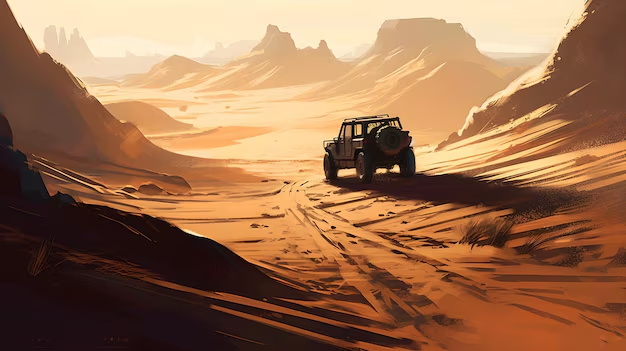The desert is a mesmerizing landscape, rich with beauty and adventure. However, it can also be unforgiving, presenting unique challenges for those who explore its vast terrain. Desert recovery services play a vital role in ensuring the safety of adventurers, travelers, and outdoor enthusiasts by providing essential support when vehicles become stranded, accidents occur, or emergencies arise. In this blog, we’ll delve into the importance of desert recovery services, the challenges they face, and tips for staying safe in these rugged environments.
Understanding Desert Recovery Services
Desert recovery services specialize in assisting individuals and vehicles in distress within desert regions. These services can include:
1. Vehicle Recovery
When a vehicle becomes stuck in sand, mud, or rocky terrain, specialized recovery services are equipped to retrieve it safely. Recovery teams utilize off-road vehicles, winches, and various tools to navigate difficult landscapes and extract stranded vehicles.
2. Roadside Assistance
In addition to recovering stuck vehicles, desert recovery services often provide roadside assistance for mechanical failures, flat tires, and other issues that may leave travelers stranded. These services can perform on-site repairs or tow vehicles to the nearest service station.
3. Search and Rescue Operations
In cases of missing persons or accidents, desert recovery teams may coordinate search and rescue operations. This involves searching vast areas, often utilizing specialized equipment like drones and all-terrain vehicles to locate individuals in distress.
4. Emergency Medical Services
Some desert recovery services are equipped to provide immediate medical assistance. Paramedics or EMTs may be part of the team, ready to address injuries or health emergencies that occur in remote areas.
The Challenges of Desert Recovery
1. Harsh Environmental Conditions
Deserts are characterized by extreme temperatures, with scorching heat during the day and plummeting temperatures at night. These conditions can complicate recovery efforts and pose risks to both rescuers and those in need of assistance.
2. Remote Locations
Many desert areas are isolated, making access challenging. Long distances between towns and the absence of cell service can delay rescue operations, requiring teams to rely on navigational skills and resourcefulness.
3. Variable Terrain
The diverse terrain in deserts can range from sandy dunes to rocky outcrops and canyons. Recovery teams must be skilled in navigating these different environments and using appropriate techniques for each situation.
4. Resource Limitations
Desert recovery teams must manage limited resources effectively, such as water, fuel, and equipment. They often need to be self-sufficient for extended periods, especially in remote areas.
How to Choose a Desert Recovery Service
When selecting a desert recovery service, consider the following:
1. Experience and Reputation
Look for services with a strong track record and positive reviews from previous clients. Experienced teams will be better equipped to handle the challenges of desert recovery.
2. Certifications and Training
Ensure that the recovery team is trained and certified in search and rescue operations, emergency medical response, and off-road recovery techniques. This guarantees a higher level of expertise.
3. Equipment and Technology
Inquire about the equipment and technology used by the recovery service. Advanced tools, such as GPS tracking and drones, can enhance the effectiveness of recovery operations.
4. Response Times
Ask about the average response times for emergencies. Quick responses are crucial in minimizing risks and ensuring the safety of those in distress.
Staying Safe in the Desert
To minimize the need for recovery services, it’s essential to prioritize safety during your desert adventures. Here are some key tips:
1. Prepare Your Vehicle
Before heading out, conduct a thorough inspection of your vehicle. Check the brakes, tires, fluid levels, and battery to ensure everything is in working order.
2. Pack Essentials
Always carry an emergency kit that includes water, non-perishable snacks, a first aid kit, a flashlight, a map, and a portable phone charger. A shovel and traction mats can be invaluable if you get stuck.
3. Stay Hydrated
Bring ample water, especially in hot climates. Aim for at least one gallon per person per day and keep a supply of electrolyte drinks to maintain hydration levels.
4. Inform Others of Your Plans
Let someone know your intended route and expected return time. This information can be crucial for rescue teams if you encounter difficulties.
5. Know Your Limits
Be aware of your driving skills and the capabilities of your vehicle. Avoid venturing into areas that may be beyond your skill level or vehicle capacity.
Conclusion
Desert recovery services are essential for ensuring the safety and well-being of those who explore the stunning yet challenging landscapes of the desert. By understanding the importance of these services, the challenges they face, and taking proactive measures to stay safe, you can enjoy your desert adventures with confidence. Whether you’re a seasoned off-roader or a first-time visitor, being prepared is key to navigating the beauty of the desert while minimizing risks. Embrace the adventure and know that help is available if you need it!


